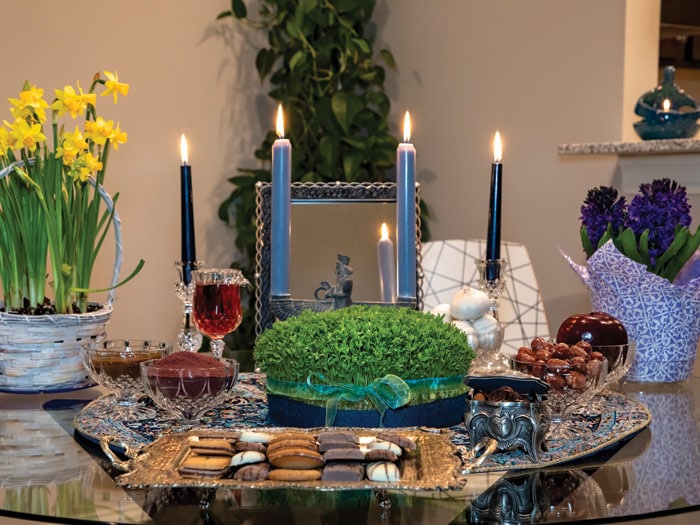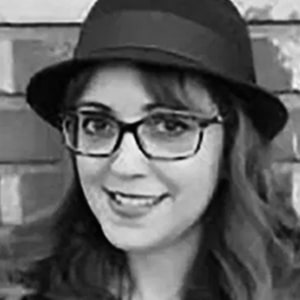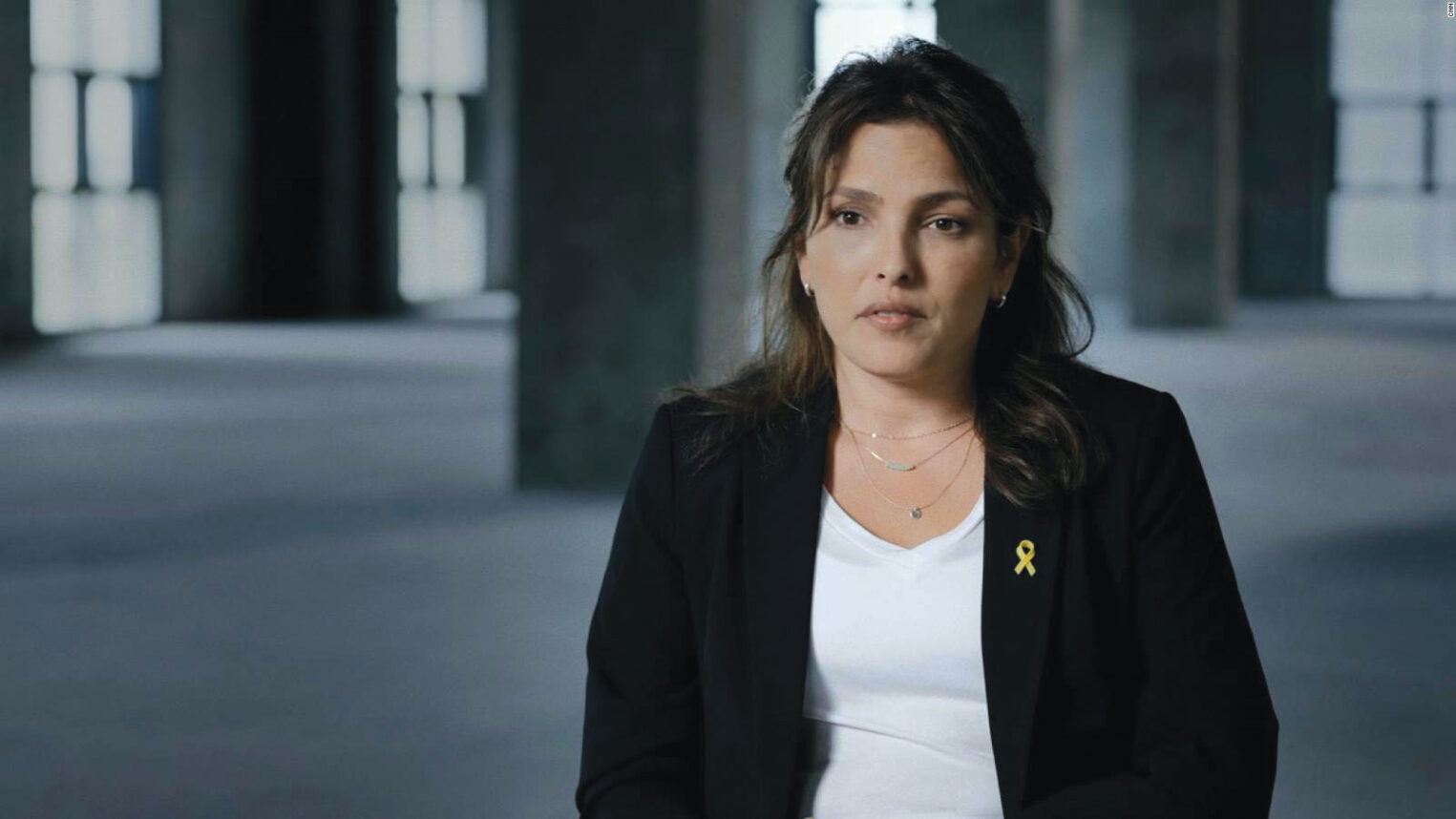 Ali Majdfar/Getty Images
Ali Majdfar/Getty Images “There’s no room on the table for the wine,” my father complained one Friday night in March 1992, when we were about to begin Shabbat dinner.
“Put it next to the fish bowl,” replied my mother.
“There’s also no room for the bread.”
“That goes next to the bowl of wheat sprouts,” my mother said.
“Goldfish, sprouts, garlic, coins — there’s no room on the table anymore,” grumbled my father, “I’m putting the chicken and rice in that little corner where I sit.”
“Make room for the hyacinths,” declared my mother as she entered the dining room with a giant vase of the fragrant purple flower and almost hit my father in the back of the head.
As I look back at this annual struggle, I realize it was the ultimate nod to our double identity as Persian Jews.
Every March, my mother laid out an incredible Nowruz (“New Day,” also known as Persian New Year) arrangement, called a Sofreh Haft-Sin, on the dining room table, with specific items symbolizing spring and rebirth. And every Shabbat in March, my father complained that he had no room for wine, bread, Shabbat dinner and his newspaper. As I look back at this annual struggle, I realize it was the ultimate nod to our double identity as Persian Jews.
Americans don’t generally know about Nowruz, and even the ones who live among tens of thousands of Iranian Americans, such as those in Los Angeles, often view it as a holiday celebrated by a small minority. But Nowruz is a huge deal, celebrated by over 300 million, from Parsi populations in India to Kurds in Iraq and Uighurs in China to Persian Jews in L.A. In Iran, Nowruz is marked by two weeks of festive celebrations. Diverse communities in areas ranging from Central Asia to the Middle East have celebrated Nowruz for over 3,000 years (it’s called a slightly different name in each country). When I was a little girl in Iran, every day of Nowruz celebrations felt like my birthday.
Children all over Iran paint eggs and place them on the Haft-Sin table as a sign of fertility and hope. During our first spring in America, I was delighted to see that some kids here painted eggs as well, though no one in my family could explain why those children also seemed obsessed with pastels and bunnies. “Rabbit and egg pictures everywhere,” my mother observed after an outing to the 99 Cents store one spring afternoon. “Maybe this is the time of year Americans try to get pregnant.” Soon thereafter, we learned the meaning of Easter.
On Nowruz, we greet one another by saying, “Eid-e-shoma Mobarak!” (“Happy Holiday” or “Happy New Year”). Some say, “Nowruz Piruz!” (“May your Nowruz be victorious”). My father’s preferred saying? “Get these goldfish off the table before I fry them up with turmeric and pepper!”
There’s so much meaning behind the seven (“haft”) symbolic items that are placed on the Haft-Sin table. All of them begin with the ‘s’ sound:
Seeb (apple): a symbol of health and vitality.
Sabzeh (wheatgrass grown in a shallow dish): a symbol of nature’s imminent renewal.
Sekeh: (coins): a symbol of prosperity.
Serkeh (vinegar): a symbol of the virtues of patience and getting better as we age.
Seer (whole heads of garlic): another symbol of health.
Samanu (sweet wheat germ pudding): a symbol of life’s sweet offerings, including fertility.
Sonbol (hyacinth): the ultimate spring blooms.
Other items include somaq (sumac) — a reminder to seize each new day and enjoy the metaphoric spices of life; senjed (the dried fruit of the lotus tree) — a symbol of love; goldfish in a bowl (they represent the importance of constantly moving forward in life and knowing when to turn and pivot); colored eggs (prosperity); an ornate hand-mirror (a reminder about the imperative for self-reflection), and candles. No Haft-Sin is complete without various pastries, including Persian chickpea flour cookies called Nokhodchi.
My favorite part of the Haft-Sin spread is a “book of wisdom” that’s placed alongside all of the other items. Muslims use a Quran, Zoroastrians display the Avesta, and more secular Iranians place the exquisite works of ancient Persian poets, including Ferdowsi’s “Shahnameh” or the “Divan” of Hafez. For their part, Persian Jews often put a Jewish prayer book (Siddur) or even a Torah in printed and bound form.
Of all our Haft-Sin items, the tiny goldfish were the most exciting for us children. A few years ago, I randomly asked a Petco employee in West L.A. if the store sold many goldfish in March. “Don’t ask,” he said. “The Persians all buy them. But they only want the bright orange goldfish. The ones who come too late get the gray ones and they never want ‘em.”
Unlike the Gregorian New Year, Nowruz doesn’t start at midnight. And unlike Rosh Hashanah, it doesn’t start at sundown. In fact, Nowruz starts at a different time each year, and is dictated by the exact moment of the spring equinox. That probably explains why one Nowruz back in college, my mother called me after midnight to wish me a happy new year, though something tells me she was really calling to make sure I was in my dorm room and not at a fraternity party.
This year, Persian New Year officially began at 8:33 a.m. on Sunday, March 20. I implored my mother not to call me that early — not because I’d be asleep, but because I’d be chasing my kids down the hallway, begging them to eat breakfast.
Though I have many fond memories of Nowruz from my own childhood, I’ve never put together a Haft-Sin table for my own American-born young children. Perhaps I worry that adding Persian New Year to the already crowded mix of Rosh Hashanah and January First will be too confusing. Perhaps I’m still suppressing some of my Persian identity because it proved such a liability when I was growing up amid shiny, beautiful blond kids in America who wondered how I’d managed to grow such a healthy mustache at the age of nine.
Here’s the truth: I’m afraid that my kids will like Nowruz, with its painted eggs, charming goldfish and sweet pastries, more than Rosh Hashanah, and my husband and I want our children to identify as Jewish first and foremost.
But here’s the truth: I’m afraid that my kids will like Nowruz, with its painted eggs, charming goldfish and sweet pastries, more than Rosh Hashanah, and my husband and I want our children to identify as Jewish first and foremost.
Perhaps introducing them to wonderful Nowruz traditions will broaden their perspectives, uplift their self-identities and help them categorize which holidays are most meaningful for themselves. During our first years in the United States, I thought my family and I would never be anything but Persian and Jewish. And then, one Shabbat dinner during the 13 days of Nowruz festivities, we quickly said the prayer over wine (kiddush), grabbed our dinner plates full of Persian stews and rice, and ran over to the TV to watch “Full House” and “Family Matters” on ABC’s “TGIF” Friday night lineup. That was the moment we became true Americans.
Tabby Refael is a Los Angeles-based writer, speaker and civic action advocate. Follow her on Twitter @RefaelTabby























 More news and opinions than at a Shabbat dinner, right in your inbox.
More news and opinions than at a Shabbat dinner, right in your inbox.